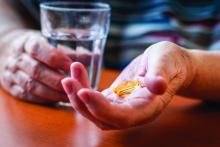Higher doses of vitamin D supplementation not only show no benefit in the prevention of falls in older adults at increased risk of falling, compared with the lowest doses, but they appear to increase the risk, new research shows.
Based on the findings, supplemental vitamin D above the minimum dose of 200 IU/day likely has little benefit, lead author Lawrence J. Appel, MD, MPH, told this news organization.
“In the absence of any benefit of 1,000 IU/day versus 2,000 IU/day [of vitamin D supplementation] on falls, along with the potential for harm from doses above 1,000 IU/day, it is hard to recommend a dose above 200 IU/day in older-aged persons, unless there is a compelling reason,” asserted Dr. Appel, director of the Welch Center for Prevention, Epidemiology, and Clinical Research at Johns Hopkins Bloomberg School of Public Health in Baltimore.
“More is not always better – and it may even be worse,” when it comes to vitamin D’s role in the prevention of falls, he said.
The research, published in Annals of Internal Medicine, adds important evidence in the ongoing struggle to prevent falls, says Bruce R. Troen, MD, in an accompanying editorial.
“Falls and their deleterious consequences remain a substantial risk for older adults and a huge challenge for health care teams,” writes Dr. Troen, a physician-investigator with the Veterans Affairs Western New York Healthcare System.
However, commenting in an interview, Dr. Troen cautions: “There are many epidemiological studies that are correlative, not causative, that do show a likelihood for benefit [with vitamin D supplementation]. … Therefore, there’s no reason for clinicians to discontinue vitamin D in individuals because of this study.”
“If you’re monitoring an older adult who is frail and has multiple comorbidities, you want to know what their vitamin D level is [and] provide them an appropriate supplement if needed,” he emphasized.
Some guidelines already reflect the lack of evidence of any role of vitamin D supplementation in the prevention of falls, including those of the 2018 U.S. Preventive Services Task Force, which, in a reversal of its 2012 recommendation, now does not recommend vitamin D supplementation for fall prevention in older persons without osteoporosis or vitamin D deficiency, Dr. Appel and colleagues note.
No prevention of falls regardless of baseline vitamin D
As part of STURDY (Study to understand fall reduction and vitamin D in you), Dr. Appel and colleagues enrolled 688 community-dwelling participants who had an elevated risk of falling, defined as a serum 25-hydroxyvitamin D [25(OH)D] level of 25 to 72.5 nmol/L (10-29 ng/dL).
Participants were a mean age of 77.2 years and had a mean total 25(OH)D level of 55.3 nmol/L at enrollment.
They were randomized to one of four doses of vitamin D3, including 200 IU/day (the control group), or 1,000, 2,000, or 4,000 IU/day.
The highest doses were found to be associated with worse – not better – outcomes including a shorter time to hospitalization or death, compared with the 1,000-IU/day group. The higher-dose groups were therefore switched to a dose of 1,000 IU/day or lower, and all participants were followed for up to 2 years.
Overall, 63% experienced falls over the course of the study, which, though high, was consistent with the study’s criteria of participants having an elevated fall risk.
Of the 667 participants who completed the trial, no benefit in prevention of falling was seen across any of the doses, compared with the control group dose of 200 IU/day, regardless of participants’ baseline vitamin D levels.
Safety analyses showed that even in the 1,000-IU/day group, a higher risk of first serious fall and first fall with hospitalization was seen compared with the 200-IU/day group.
A limitation is that the study did not have a placebo group, however, “200 IU/day is a very small dose, probably homeopathic,” Dr. Appel said. “It was likely close to a placebo,” he said.


